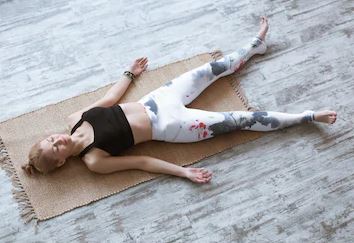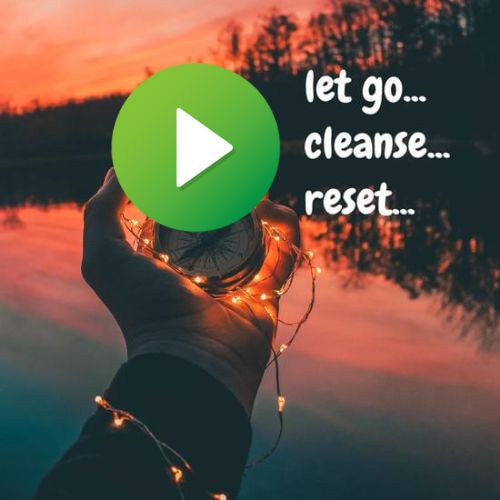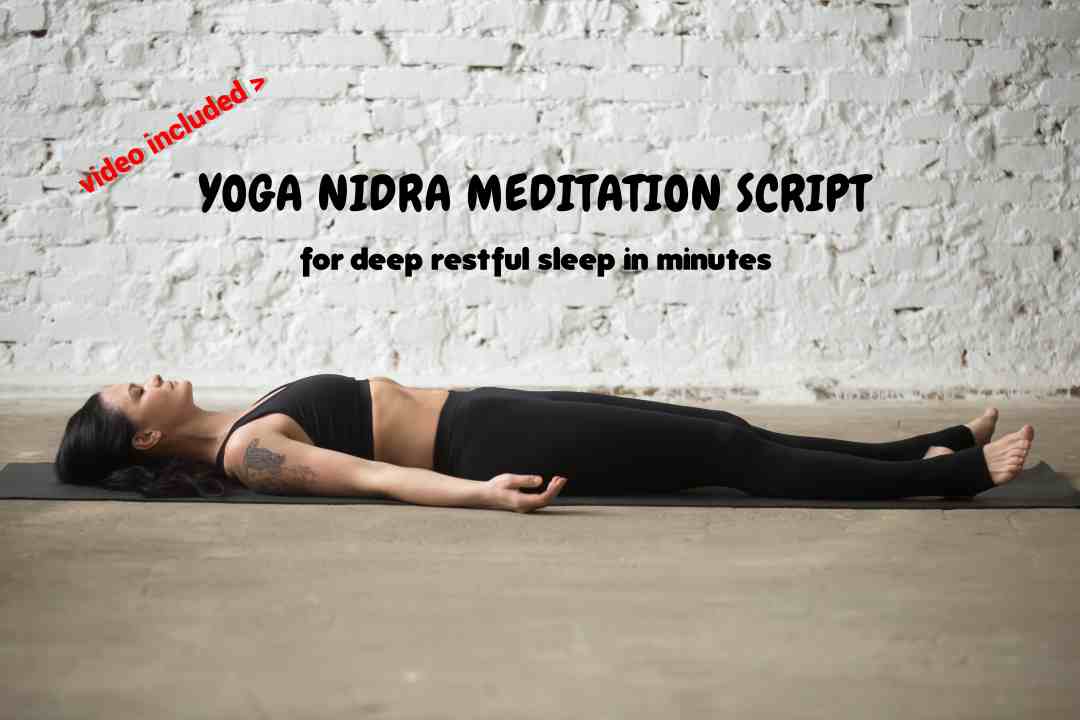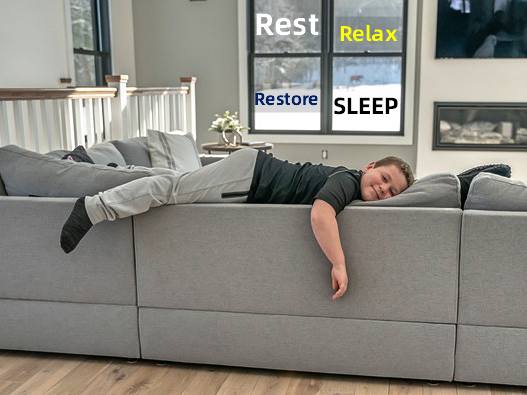Corpse Pose (Savasana or Shavasana) in Yoga is the traditional final resting pose after practising Yoga poses. ‘Sava’ literally means ‘dead-body’. When your body and mind is overworked it is obvious that they perform below their normal efficiency. Due to the modern-day lifestyle including food, work, social life, entertainment makes relaxation – quite a task.
Most of you have forgotten the eternal fact that rest and relaxation is the natural way of the body to recharge. In modern times, even when you are relaxing you keep your brain engaged thinking about the tensions in life. Therefore, you end up spending a lot of energy from your body.
You even keep the muscles ready to work than actually working. In order to regulate the energy of the mind and body, it is best to balance them to use the energy economically. You can best do this by relaxation during the Corpse Pose (Savasana or Shavasana). When you are in a complete relaxed state – there is minimal or no energy or prana – that gets consumed. The energy is conserved and preserved while you are in this relaxed state using only enough for circulation.
To attain a complete state of relaxation Yogis use three methods: mental, physical and spiritual relaxation. You can only achieve complete relaxation when you reach the stage of spiritual relaxation.
It seems quite easy yet, this pose is difficult because you need to bring your body and mind to a calm state.
Corpse Pose in Yoga (Savasana or Shavasana) instils deep healing and relaxes your body and mind.
Steps to follow for Corpse Pose (Savasana or Shavasana)
Step 1:
Lie flat on the Yoga mat or rug on the floor with your eyes shut as if you are a ‘Corpse’ literally. Become comfortable yet do not use any pillow or cushions for support.
Step 2:
Place your legs comfortably apart. Also, make sure your feet relax completely and are 2 feet apart. make sure the legs are straight but not tensed. Your toes are facing sidewards. Your arms, however, must be placed along your body and slightly apart at 45-degree angle from the body. Leave your palms open and facing upwards and fingers slightly curled. Eyes should be closed.
Step 3:
Relax your mind and body as much as you can when you are in the Corpse Pose. Focus your mind on your breath. Try and avoid your mind to dwell on outward thoughts.
Step 4:
As you Breathe in the abdomen should rise. As you exhale your abdomen should fall. Breathe in through the nose (not through the mouth). Never strain or breathe forcefully.
Step 5:
As you lie down quietly in the Corpse Pose (Savasana or Shavasana) send signals of relaxation to your body. Shake your shoulders to loosen up any tension. Roll your head from side to side and bring the head back to the centre and focus your mind on your breath.
Relaxation Between Yoga Poses
As you perform various Yoga poses or Postures – each asana or pose has it’s own rhythm as it alternates between effort and relaxation. In some Yoga Poses – you stretch your muscles and then relax, however in other poses you contract the muscles and then relax. Therefore, it is a pattern of effort and releases – to your nervous system as you relax between Yoga Poses or asanas. Thus, as you reach the relaxation stage of Corpse Pose or Savasana – your nervous system is balanced so that just by visualising yourself relaxing you can relax. It is almost like auto-suggestion.
Thus, it is important to relax between each Yoga Pose or asana. Because it is the best way for your body to absorb the effects of the pose and get re-energized.
Duration of Corpse Pose between Yoga Poses
Relaxation or Corpse Pose should be for 8 breaths minimum, but not more than 2 minutes. This is so that your body is still warm to perform the next Yoga pose or asana.
Final Relaxation in Corpse Pose (Savasana or Shavasana)
At the end of your Yoga Session – you should practice Final Relaxation in the Corpse Pose (Savasana or Shavasana) for 15-20 minutes. It will be for the final mental, physical and spiritual relaxation – the ultimate Yoga experience.
Remember, you will feel the blood pressure or body temperature drop depending on the season when you are practice Corpse Pose. If you feel cold, you can cover yourself with a think blanket loosely before you start the Pose.
Be in a comfortable Corpse Pose before you practice the physical, mental and spiritual relaxation exercises in the order in which they are suggested.
Corpse Pose (Savasana or Shavasana) – for Final Relaxation (15 Minutes Total)
Part 1: Physical Relaxation
Duration: 8-10 minutes
Prepare to Relax
First, when you think about the corpse pose – you may feel it does not require any efforts of muscles to relax. yet, it is a myth. Many of our muscles are still tensed while we start to prepare for the Corpse Pose. It maintains stress levels in our nervous system and brings down the body’s energy levels.
To prepare for final relaxation in Corpse Pose – you go through short muscle contractions. These are to be followed by suddenly releasing your muscles completely. It removes any of the tension that may be remaining. Thus, follow these active relaxations before you go into Final Relaxation of Corpse Pose (Savasana or Shavasana). Active relaxation should take at least 1 minute.
Active Relaxation Steps of Corpse Pose (Savasana or Shavasana):
Step 1:
Lie flat on your back. Keep your arms and legs slightly apart and relaxed.
Step 2:
While you inhale deeply lift your right leg approximately 2 inches (5cm) above the floor. For a moment you should hold your breath while focusing on contracting the muscles as you defy gravity. After this – exhale and drop your leg back to the Corpse Pose. Feel the leg relax as you breathe slowly. Again, Inhale and repeat the step for the left leg.
Step 3:
After you inhale deeply, clench both your fists while listing your arms off the floor. Hold your breath while clenching the fist and then exhale while dropping your arm on the floor. Next, lift both the arms – opening out the palms of your hands and stretch your fingers wide apart loosening the muscles and drop your arms again on the floor and relax.
Step 4:
Contract your buttocks as you lift them off the floor slightly. Hold your breath and then exhale as you drop your buttocks down on the floor.
Step 5:
Push your chest up as you inhale – so that your shoulder blades come together. After holding your breath – exhale while releasing the upper back on the floor again.
Step 6:
Pull your shoulders upwards and forwards while you inhale. Bring your shoulders near your ears, so that your arms slide along the floor. As you hold your breath, tighten your shoulder muscles before you exhale and relax to release the shoulders to a normal relaxed position.
Step 7:
Squeeze your facial muscles tightly together as you inhale. Hold your breath while you hold the muscles tight for a few seconds and then exhale and release the muscles.
Step 8:
Oen your mouth as you exhale, pop out your tongue and look up towards your forehead. Hold your breath for a few moments, before you exhale and bring the tongue back inside the mouth and relax.
Step 9:
Gently roll your head to one side as you inhale and exhale as you roll it on the other side. Repeat the rolling several times to allow the neck to relax. While doing this exercise the base of the head should be on the floor – never lift your head off the floor.
Mind and Body Connect – Corpse Pose (Savasana or Shavasana)
Every action is a result of a thought that originates in the mind – be it consciously or unconsciously. Thoughts trigger action, therefore, the body reacts. Muscles are given the command by the brain to contract. Similar to this the thoughts sends signal or vibrations to relax. The message of relaxation is called – Autosuggestion. It is when you suggest your muscles and internal organs go in a relaxed state.
Step 10:
Since we do not have control over the organs like heart, brain, lungs, liver etc – our thoughts cannot directly send them messages to relax. However, they also need to relax so that they become more efficient. Thus, the Yogis use the subconscious mind to control the automatic functions of these organs to relax. The message sent by the conscious mind to the particular organ(heart or liver) is received by the instinctive mind. It immediately carries out the order.
Therefore, you can recall all the involuntary organs as well. You can start with your toes and move the body part by body part to the top of the head where the eyes and ears are. After this, slowly, you send messages to the kidneys, liver, stomach, spleen etc. It is the way your body goes into full relaxation in the Physical State during the Corpse Pose (Savasana or Shavasana).
Step 11: Auto -Suggestion
Inhale and exhale deeply using rhythmic motions using your abdomen while lying in the Corpse Pose (Savasana or Shavasana). After this follow the exercise of autosuggestion for 5-10 minutes. Visualize your feet and say “I am relaxing my feet, my feet are relaxed.” Move upwards on your body and pass this auto-suggestion to each and every part of the body one by one. Relax your ankles, calves, knees, thighs, hips and buttocks. Relax your abdomen, chest, lower back, middle back, upper back, shoulders, neck, fingers and hands, arms, eyes, mouth, ears, nose, chin, facial muscles and scalp. After this, finally, relax your internal organs one by one. Send autosuggestion to your kidneys, liver, bladder, pancreas, intestines, heart, stomach, lungs, brain and uterus. It is your subconscious mind that conveys the command.
Part 2: Mental Relaxation
Duration 1 – 2 minutes
You may not know that a lot of your energy is wasted in mental tension like worries or anxieties. The energy consumed could be much more than the physical tension you face. When you face mental tension you should breathe rhythmically – slowly and deeply with your focus on your breath. As you do this for a minute or two you will calm down your mind and feel a floating kind of sensation. It is a feeling of peace and joy as if you are as light as a feather floating in the sky.
Part 3: Spiritual Relaxation
Duration 4 – 5 minutes
No matter how much you try until you practise Spiritual relaxation you cannot remove the worries in your mind completely. Yogis understand that one has to withdraw oneself from the body and separate from the ego consciousness. It is the only way to attain complete relaxation.
Once he achieves mental relaxation he withdraws himself. He identifies himself with the “all-pervading, all-powerful, all peaceful, joyful self, or pure consciousness within himself because the source of power, knowledge, peace, and strength is in the soul and not in the body.” Man falls prey to the emotions of the mind and starts identifying himself with the mind and body. There is only one way “to free himself by asserting his real nature that is, “I am that pure consciousness or Self.” Therefore when one identifies with the SELF- the relaxation process gets completed. This position of relaxation is called the “Savasana or the Corpe Pose” in Yoga.
Example of Spiritual Relaxation
Just imagine a lake that is crystal clear and serene and quiet. Now visualize the movements of your thoughts similar to the ripples on the lake’s surface. Slowly and gradually let the ripples of the thought waves settle down and subside so that what remains is the deep inner SELF. Almost as if you can see through the crystal clear lake. See-through its calm and clear water up to the bottom of the lake.
Coming out of Relaxation (Mental, Physical and Spiritual)
Step 1:
After you visualize for a few minutes – the mind has a natural tendency to start moving on its own all over again.
Step 2:
Inhale and exhale deeply few times and now slowly start moving your arms and legs.
Step 3:
Next, stretch your arms above your head stretching them behind.
Step 4:
Now slowly sit up into a cross-legged position and end the session by thrice chanting “Om” the Universal sound. It is the most effective way to maintain all three levels of relaxation for the rest of the day even after you come out of the Corpse Pose (Savasana or Shavansa).
Related Articles:
How to do Surya Namaskar – Steps with Images and Video
What is the Ayurvedic Perspective on Raw Food
10 Best Anxiety Management Techniques
7 Amazing Health Benefits of Turmeric – You never Knew
http://wordpress-334546-1028402.cloudwaysapps.com/fish-pose-matsyasana-steps-benefits-wellnessworks/
http://wordpress-334546-1028402.cloudwaysapps.com/yoga-poses-to-improve-bad-posture-at-work/
http://wordpress-334546-1028402.cloudwaysapps.com/steps-plow-pose-halasana-benefits-yoga-wellnessworks/
http://wordpress-334546-1028402.cloudwaysapps.com/yoga-for-sleep-insomnia-deep-relaxation-wellnessworks/









One Response